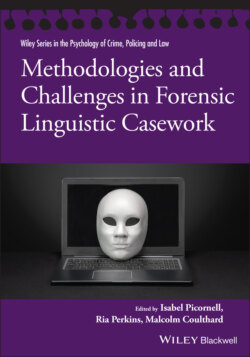Читать книгу Methodologies and Challenges in Forensic Linguistic Casework - Группа авторов - Страница 28
EVALUATION OF METHOD
ОглавлениеAt this stage of the analysis, three aspects of the procedure come to the fore.
First, many of the features derived in the initial analysis of known texts simply did not appear in the disputed material. This is a cost of structuring the analysis as we did and might represent considerable wasted effort in identifying and counting features that turned out to be irrelevant to the analysis. We would argue that although this is wasted effort, it is a worthwhile price to pay to mitigate potential bias. Furthermore, some of the features extracted through this process were crucial to our analysis and may not have been identified otherwise. Although this did not figure in this case, this approach also allows for active consideration of features’ non-occurrence in disputed material and whether conclusions against an attribution might be drawn on this basis.
Second, as noted, many texts were not attributable. Features did not occur, or the picture was too mixed, to make an attribution. In the Starbuck case, this did not significantly affect the overall conclusions as there were sufficient disputed emails we could attribute to support writing an evidential report. Also, the date-stamping of the texts allowed us to place the attributable texts in the time series and from this support reasonable (nonlinguistic) conclusions to be drawn about other emails in the timeline.
Third, the combination of stylistic and stylometric methods meant that we minimized the risk of finding new features in the disputed material, which retrospectively might have been detectable in the analysis of known emails. There is a risk in deriving features only from the texts of known authorship that important features might be missed. The whole effort to avoid bias is set against retroactively considering new features not identified at first pass. This should not be done as such post hoc fishing for features to further bolster an analysis once a conclusion is partially drawn is, by definition, biased. Once one has made a firm attributive decision, by definition looking for further features to support that decision counts as looking for confirmation.
A case might be made to return to the analysis to look for features to contradict the conclusion, but this would require careful planning and discussion in advance as to how any results might be treated. It is thus important to employ a strategy that minimizes missing features in the analysis of known materials. One consideration for future analyses might be that it would be worthwhile to post hoc search the disputed material for evidence contrary to the conclusion drawn as a check on the attribution, but this would require careful planning and discussion in advance as to how any results might be treated. That was not done in this case.
